I had been waiting on a review that could read to give me some insight into whether this might be a game for me given the more than spotty track record of Modern War and the tendency of Miranda’s voluminous opus of work to be under-tested or developed.
“Just finished Decision: Iraq “
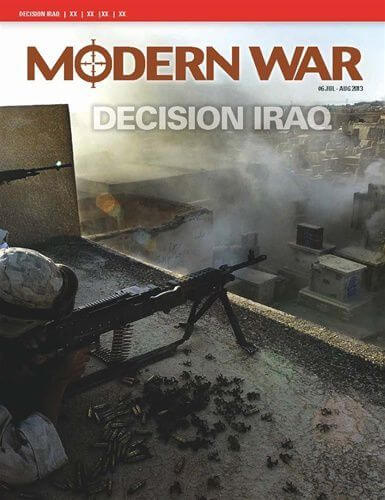
The Modern War magazine games seem to be much maligned – possibly due to the fact that, as I said before, they only seem to be playtested by Joe Miranda, Eric Harvey and me!
No proper reviews of this so I’d thought I’d have a go.
Decision Iraq : Modern War Magazine No. 6
Designed by: Joe Miranda
Players: Two (but works well solitaire)
Theatre (Operational?) level modeling of Coalition Multinational Forces (MNF) vs Iraqi and Foreign Insurgents in post 2003 invasion Iraq from 2003 – 2008. Each turn is 6 months.
Map: Area control – each territory box represents a geographic area of operations and is divided into “open” and “infrastructure” sections.
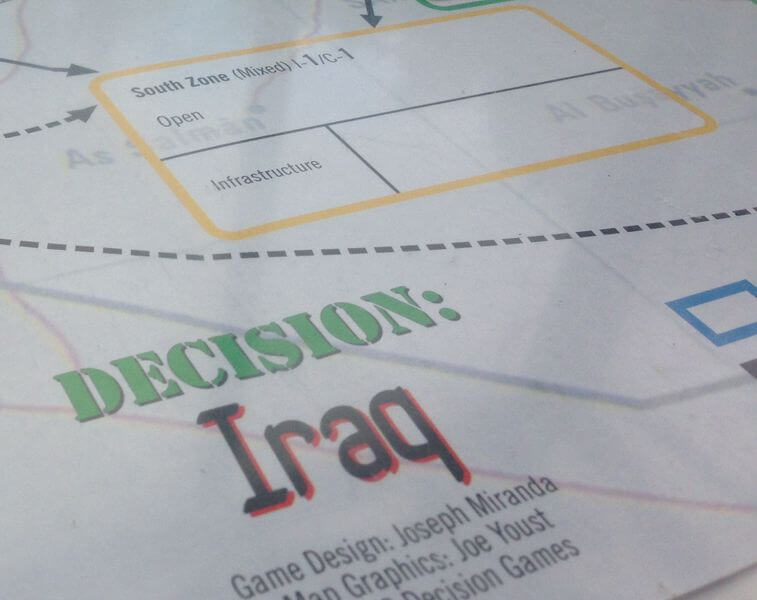
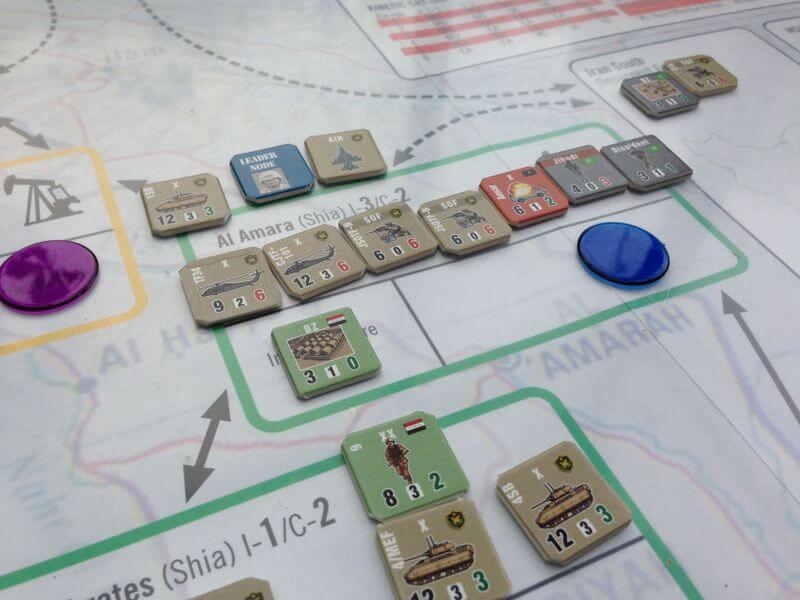
You need forces in the infrastructure boxes to claim territory and receive netwar points at the end of each turn. (they represent your forces basing themselves amongst the people and providing visible security rather than basing in FOBs outside town and performing drive-by patrols)
Scale: Each counter represents a named MNF BCT, Division or Iraqi brigade and Insurgent Militia and Jihadi cadre’s(?).
An initiative based on baddies go first as you are in their yard, but I used a D6 roll to decide after the first turn.
Phases:
1) Chaos phase : Each payer rolls 2 D6 on their respective chaos event table and applies the result.
2) Mobilisation phase: where netwar points are used to “purchase” forces and “Netwar Chits” which add modifiers to recruitment of forces, combat differential rolls and negation of the other player’s netwar chit effects.
3) Movement Phase: Via the open or infrastructure areas of the territory box. One movement factor between territory boxes or intra-section movement between the open and infrastructure boxes. Conventional units must stop when entering an open territory box containing opposing forces. SOF and Jihadi units can infiltrate and pass through the open areas even if contested.
Optional rules for Airmobile transport (and riverine ops), the effect of presidential elections and force recruitment taking into account Sunni / Shia sectarian divisions.
4: Conflict Phase:
Traditional part – Each side adds combat factors, calculates a combat differential between attacker and defender modified by a D6 die roll.
Results expressed as a stepwise increment / decrement of forces plus netwar point gain or loss.
Open areas must be “cleared” before infrastructure area combat can occur.
This is the really innovative part that I think worked brilliantly and really added to the theme – 3 types of combat differential table with variable results and penalties depending upon the type of combat, namely CIMIC, COIN (guerilla) or Kinetic.
SOF forces (and certain netwar chits) allow Kinetic combat in the infrastructure sectors. Conventional units must use CIMIC/COIN tables when engaging infrastructure forces – unless ALL attackers are SOF / Airmobile/ Jihadi with red movement factors.
Lots of opportunity here for careful consideration of your approach to combat operations.
(Interestingly Joe uses a similar mechanic in Struggle for the Galactic Empire where you have the option of “Morphogenetic Combat” (Psi Ops) which converts enemy forces to your side or Kinetic combat which does what it says on the tin and destroys enemy units.)
5) Control phase: Territories are controlled by the side that has forces in the infrastructure boxes even if opposing forces are in the open areas.
Points (the amount depending on the level of operational importance to each side) are added to the netwar points track of the controlling player at the end of the turn.
6) Attrition phase: occurs on “A” years e.g. Turn 2 is “2004A” – Half of Iraqi and Insurgent Militia units desert if they remain in a territory controlled by enemy forces.
Victory Conditions: Whoever has the most netwar points at the end of the 2008 turn wins. Instant loss occurs if either players netwar index goes below zero.
How did I fare playing both sided to the best of my ability?
Coalition / MNF victory 86 netwar points (36 plus 50 for reducing insurgent points below zero with this attack in Al Qaim.
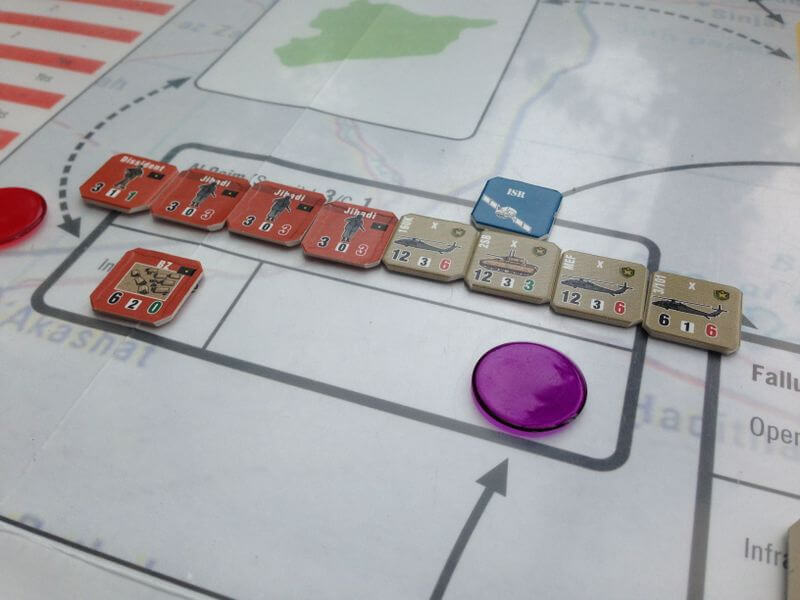
Victory (in a spooky mirroring of Gen Petreus’s COIN tactics) came about through NOT drawing down boots on the ground but by maintaining a strong MNF force presence, by building FOBs and Iraqi Base Zones in the infrastructure areas and leaving them securely in the hands of Contractor security forces (and if desperate Iraqi Brigades).
This approach even forestalled a Jihad that was called by the Insurgents (when their netwar points got below 25)that led to an influx of, surprisingly enough, Jihadis into Al Anbar and Baghdad East where it got really nasty mid game.
Even the Green Zone was taken over for one turn but reverted to MNF after some Kinetic action and help from Air Assets (allows you to choose ANY ratio column the kinetic CRT – although it risks an “overkill” result.
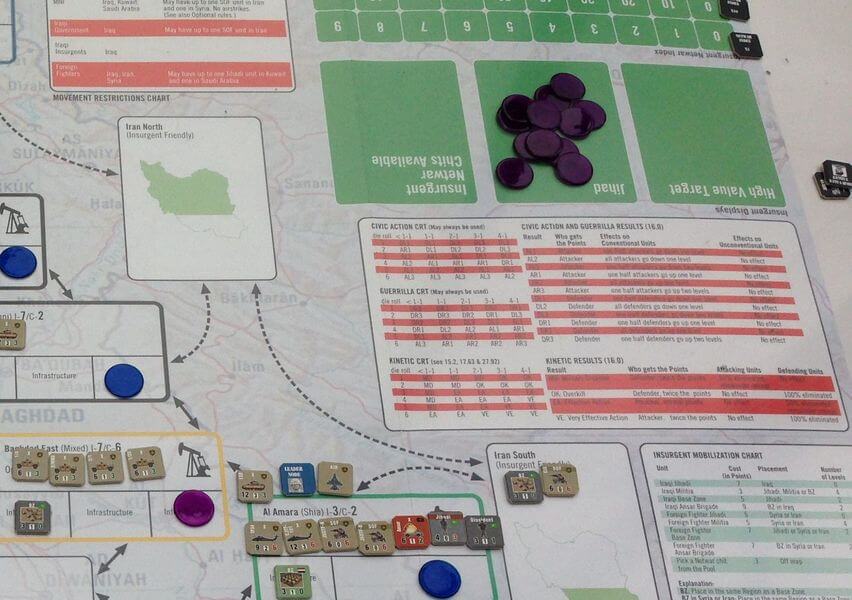
Overall state of Iraq at the “end of hostilities” before the real shit goes down and AQI transform into ISIS.
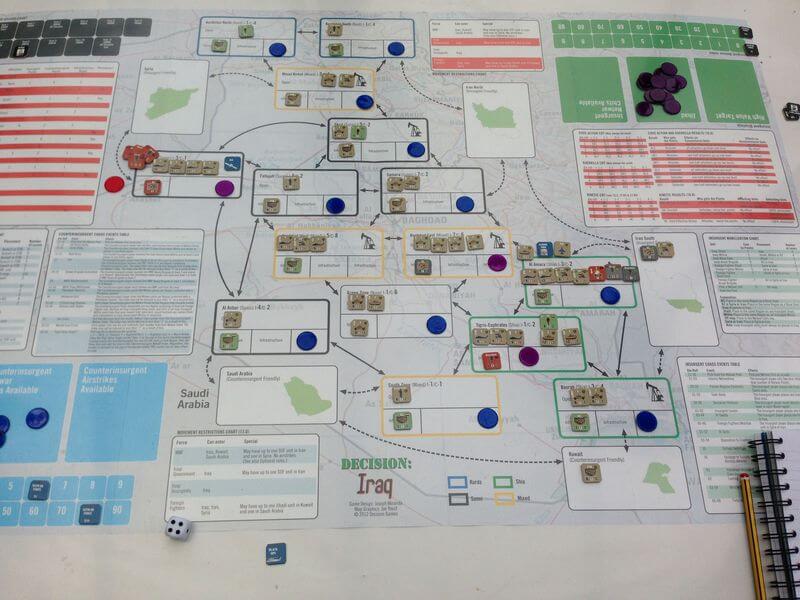
Blue discs indicate MNF held areas, Purple are insurgent.
Notice the ominous presence of an insurgent base zone and in Southern Iran which the CIA SOF were planning on sanitising (they had just kicked ass in Syria on the previous turn. Also note the Al Ansar Brigade suicide bombers and Jihadis who have infiltrated from Southern Iran into Al Amara on the previous turn.
Guess what they’ll do after the MNF draw down and leave it in the hands of the poor Iraqis.
It may not have the OCS level of detail and chrome and many people complain about Joe’s magazine games but I feel it seems to produce plausible results and mirror the fluid nature of an insurgency.



 OUT OF FIVE.
OUT OF FIVE.
C’mon Kev! Your turn to buy a mag wargame after I got burned by Op Nuremberg!
hahaha. No thanks! Between Bomba and Miranda and a few other pulp game designers, Im moving almost 100% away from games in magazines
“pulp” game designers” – first time I’ve seen that term!
kind of like the Romance novel of the week…same story different character names in a different setting.
I didn’t care so much for this system, even though I had to tear the original engine out of my Greek Civil War game and substitute this one to get it published in DG’s Modern War magazine (where the rest of the design was destroyed in several other ways).
The three different CRTs idea comes from James Dunnigan’s old Chicago-Chicago! game originally and Joe has used it several times: LA Lawless, Decision Iraq, War in the Megacity etc.
Not the way I would do it but it is a workable system to reflect some aspects of insurgency.